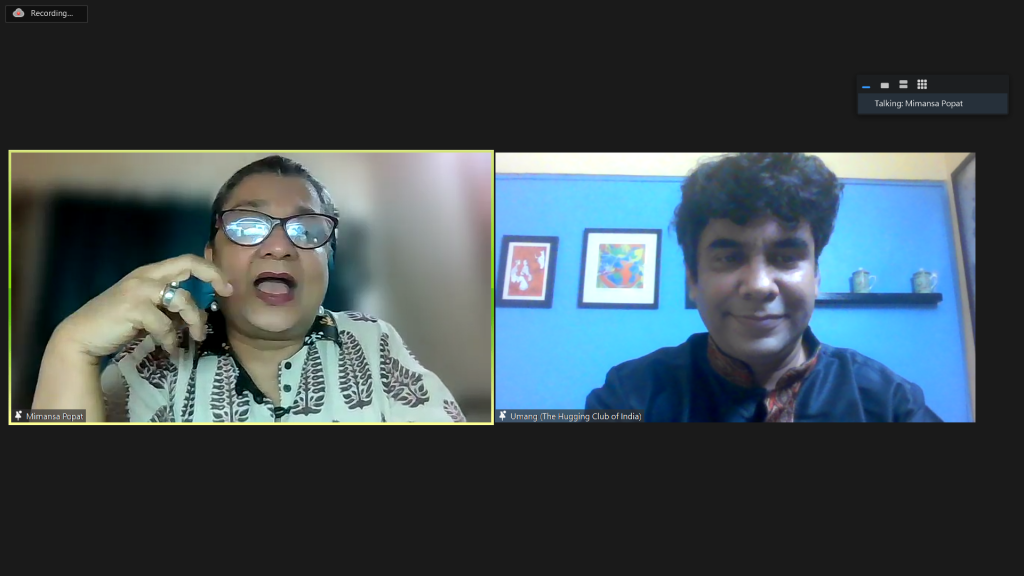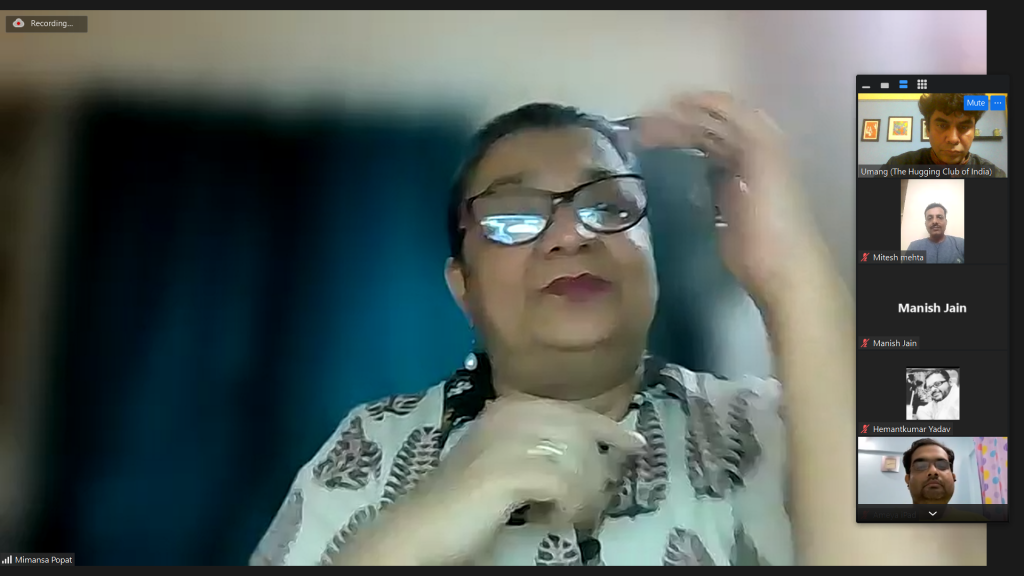We were fortunate to have a special guest Ms. Mimansa Popat, a distinguished authority on integral somatic psychology, who took time out from her busy schedule to share her expertise on an online session. Ms. Mimonsa has 25 years of experience as a remedial educator. She conducted the session on the topic of ‘Emotional Regulation’ on 19th July 2023 for Hugging Club of India.

Ms. Mimonsa delved straight into a mindfulness breathing exercise with the participants joining in. She then asked us to imagine a peaceful, serene environment while breathing to create a distinction between simply breathing and a scenario where peaceful environs was also created in the mind.
Next, she asked us to imagine a contrasting scenario where someone has compelled us strictly to come to this session and we have braved rain and muddy water to reach the destination. This would naturally make us anxious and we would want to make sure we do not disappoint anyone and reach on time. Our body may get constricted, the heart may beat a bit faster or slower than normal and our normal breathing rhythm may change. This means our emotions are affecting the physiological reactions in the body. We would do any of these two things in such a scenario:
1. withdraw (feel demotivated, don’t want to work, don’t want to engage with people), or
2. retaliate (feel angry, hyper-active, over think, over-react, get aggressive)

Our reactions can vary between the two in various situations. So we go into a concurrent pattern, either we withdraw in some stressful situations or we sometimes retaliate. When this happens, people around us begin to judge us as moody or even fear us. We would come across to them as unreliable, as there is no consistency or continuity in our moods. It swings between the two extremes. But what is actually happening is that we are simply displaying physiological reactions to difficult or stressful emotions.
The emotions that cause our body to react can either be something we are presently experiencing or something that has occurred in our past. For example, when a child is walking with his mother and slips on a puddle of water, he gets hurt. The child would naturally expect his mother to comfort him and hug him. But instead the mother gets angry and scolds him for not being careful and not listening to her and may even spank the child. The child may then begin to realise that he cannot expect his parent to be there for him in case something bad were to happen. He becomes, what is known as, a precocious child. Slowly as his age progresses, he may stop taking risks because he sub consciously fears the outcome, in case he fails. For example, if in his young age, he develops good skills at designing presentations and he is requested to present on a topic, he would try to avoid doing the presentation and instead give it to a colleague or friend to do it on his behalf. This is to avoid a scene where he may be critiqued or told off on the task. Subconsciously, he is still operating from his childhood hurt and his personality therefore becomes a precocious personality and low on self-confidence. He is portraying a person that he may not actually be, had it not been for that experience in childhood. The takeaway here is that we should be aware of why we may be behaving the way we do to avoid being hijacked by our emotions.

We need to acknowledge our emotions and feelings, instead of either repressing them or behaving as if it was not a big deal. For example, the emotion of fear is not necessarily in the heart. It can be in the head or in the knees. Notice how the fear is playing out in the physiology and then sit with that fear long enough and allow it to expand to other parts of the body. This is done to spread the emotion across to allow the body’s physiology the capacity to deal with that fear. In case the fear does not spread, there are mindful touching techniques to allow the fear to expand elsewhere. The point is that our mind and body are elastic. When the emotion of fear is spread out, we are thinning it out, so we can negotiate that fear and deal with it.
Suppose someone has insulted you and you are feeling angry. A therapist would explore beyond the primary emotion of anger to reach the root case of whether the anger comes from secondary emotions like hurt, shame, feeling of inadequacy or helplessness. The therapist would try to expand these secondary emotions in the body so that the affected person feels it easier to deal with these emotions. Over time when this is practiced, the person develops a capacity to function even while dealing with these emotions. When emotions are expanded, we do not allow them to be entrenched within ourselves.

Setting boundaries for others to avoid invasion of your personal space was also an important concept explored in the session with a couple of examples.
How do we get over other’s perception of you as a people pleaser? The simple response was to stop being a people pleaser. Further, ask yourself why you are a people pleaser. Is it because you want affection or is it because you don’t feel loved enough? If we don’t feel loved, it could be because people who were supposed to take care of us did not do so as per our expectations in our early years.
Mimansa shared her own experiences as a child, which was very inspiring. She had learning difficulties (dyslexia) but her father was very accepting of it and supported her. She was mischievous and had to change 5 schools because of it. But she eventually found a mentor who was able to channelise her overactive energy in sports to bring it down to a lower level and due to that she was able to focus on her studies as well. She explained it beautifully when she said we need to look at special children as a glass where the Lord has put a drop of water. That drop itself means there is a potential to grow a seed there. Don’t look at the almost empty glass. Realise that potential. It was a very touching metaphor.

It is only recently that people have begun accepting that emotional dysregulation causes learning disabilities. Earlier it was only regarded as a neurological dysfunction. But even if it is considered a neurological dysfunction, the neurology is known to work with chemicals and how do we get chemical changes in our body? The answer is simple – by emotions. So, if our emotions are regulated, then the chemical imbalance will be less. The neurological dysfunction will still manifest, but at a much lesser and manageable level. This was profoundly insightful.
Mimamsa also emphasised the need to drink a lot of water as the energy within our body moves with water.
The latter part of the session was the audience questions which Mimansa responded to and her direct replies peppered with appropriate examples reflected the depth of her experience.

In the end it was an insightful, thought-provoking and educative session and we would be glad to have Mimansa back to gain more from her wealth of knowledge about her subject.
– Written by Amit Rai
– Compiled by Amol More
– Edited and uploaded by Mahrukh
